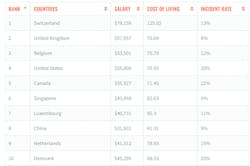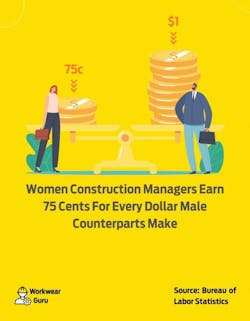Motivating Tele-Construction Talent
Construction is booming. Skilled workers signing on to work in construction? Not so much.
With a projected growth rate of 3.1% in 2022, construction is one of the fastest growing industries in the US and is #4 in the world. (See Figure 1.) The demand is expected to add 650,000 jobs this year, according to the Associated Builders and Contractors (ABC). As of February, the industry already added 60,000 jobs, according to data released by the U.S. Bureau of Labor Statistics. “This workforce shortage analysis sends a message loud and clear: The construction industry desperately needs qualified, skilled craft professionals…,” said Michael Bellaman, ABC President and CEO.
The US does well on the world stage in terms of construction compensation. The average salary of a construction worker here is $55,800. (See Figure 2.) But, in terms of salaries, that’s below the national annual median income of $63,688, according to the most recent data from www.investingsimple.com.
Where does tele-construction fit into this equation and how can this subset of the construction industry attract top talent to help with its build-out backlog?
While we don’t have exact salary data for tele-construction workers, let’s work on the assumption that it’s similar or a bit less than the average salary in construction.
Then, let’s examine some additional reasons talented workers aren’t jumping into the construction (and tele-construction) pool with enthusiasm.
A recent article titled “The $65B Gordian Knot” by Michael Render, confirms the Telecom/ICT industry is facing a similar-long-term problem like its ‘construction’ cousin. And, that problem could impact scaling 5G across the country.
Who Needs What?
Way back in 1943, Maslow, a psychology guru, created a motivational hierarchy that explains how we are driven to be the very best version of ourselves. Maslow suggested we are motivated to fulfill basic needs like safety and security before moving on to other, more advanced needs, like love and self-actualization. (See Figure 3.)
Given Maslow’s theory of motivation, let’s look at why construction and tele-construction may not be attractive. While the US ranks number four in the world in terms of providing the best opportunities for construction workers, the US does not deliver in two areas:
- Safety: Approximately 20% of worker fatalities in the US are in construction, according to OSHA.
Even construction “helpers” have the 4th most deadly job in America, according to the U.S.
Bureau of Labor Statistics Census of Fatal Occupational Injuries. These helpers are construction
workers who assist trade workers during construction. The most common cause of death for
these workers are falls and trips on construction sites.
- Security: The definition of this is being free from danger or threat. Unlike safety, security is difficult to measure. Still, the two are linked. Given the safety statistics noted above, can construction and/or tele-construction workers feel safe and secure in their jobs?
So, why aren’t women taking construction jobs? It could be salary. It’s well-documented that women normally make about 84% of what men do. In construction, however, the gender pay gap is worse with women making about 75% of men.
Tele-Construction and Broadband Gordian Knot
A recent article titled “The $65B Digital Divide Gordian Knot” by Michael Render (https://isemag.com/2022/02/telecom-ict-2022-65b-infrastructure-plan-challenges-solutions/), confirms that the Telecom/ICT industry is facing a similar long-term problem like its “construction” cousin. And, that problem could impact scaling 5G across the country.
“Veriforce reported on a survey of telecom executives who were said to collectively employ more than 240,000 contractors. According to the study, the top challenge facing telecom companies is currently skilled workforce availability, with 86% of company executives naming skilled labor as the top challenge facing the industry.
Meanwhile, underlying activity for other telecom work, especially 5G, is also expanding, placing further stress on employment resources. Closer and more frequent 5G towers are primarily served with fiber all the way to the radio head. Twelve (12) leading telecom industry trade associations wrote a letter in January 2021 to President Biden urging more workforce development. It was projected that 5G alone would create 3 million direct and indirect jobs by 2025. A letter from the 5G industry concluded “While the jobs are there, our American workforce is not currently ready to fill them.”
Michael Render is Owner/Principal of RVA LLC. He has over 35 years of marketing research experience, including corporate consumer and B2B brand leadership. For more information, email [email protected] or visit www.RVALLC.com. Follow Michael on Twitter @MichaelCRender and LinkedIn.
The Missing Gender
Interestingly, women comprise only 10.9% of all people working in construction, according to the U.S. Bureau of Labor Statistics. The number of women on the front lines of a job site is far smaller—only 1 for every 100 employees in the field. Considering that women are 47% of all employed individuals, this means the construction industry is only benefitting from about 1.25% of women in the workforce, according to a report titled “Women in Construction: The State of the Industry in 2022”.
So, why aren’t women taking construction jobs? It could be salary. It’s well documented that women normally make about 84% of what men do. In construction, however, the gender pay gap is worse with women making about 75% of men. (See Figure 4.) Based on the $55,800 noted above, women’s average salary would be $41,250, considerably below average.
In addition, women also face sexism. The Women in Construction research done by Workwear Guru shared that 47% surveyed believe the industry’s male-dominated culture is the main reason their female peers leave the industry. Another 38% consider outright discrimination as the reason why women quit.
So, even if the construction/tele-construction industry could attract women, given that about 47% of them would leave due to the issues we just discussed, their leaving is quite costly. Turnover can be 33% or more of employees’ annual salaries, according to Yahoo finance.
The cumulative nature of this problem impacts many things, including companies’ profitability. A recent McKinsey & Company study shared that most gender-diverse companies are 25% more likely to achieve above-average profitability than companies with less diversity. So, the loss of women in construction is a loss for stakeholders and shareholders.
Remedying the construction and tele-construction labor shortage is a more complex issue to resolve than it appears on the surface. Until workers’ fundamental needs for equitable salary, safety, security, and gender-fair work environments are addressed, the construction/tele-construction industries will have difficulty attracting and retaining talent and enjoying the profit-raising possibilities diversity offers.
RESOURCES AND NOTES
https://workwearguru.com/women-in-construction/
https://www.simplypsychology.org/maslow.html
https://workwearguru.com/best-countries-for-construction-workers/
https://www.abc.org/Portals/1/CEU/Construction-Spending-2022.png?ver=2022-02-22-102511-743
https://www.constructionnews.co.uk/agenda/inspire-me/is-gender-bias-in-construction-getting-worse-or-are-women-less-likely-to-stay-quiet-19-03-2020/
https://www.bigrentz.com/blog/women-construction
https://www.bls.gov/cps/cpsaat18.htm
https://www.mckinsey.com/featured-insights/diversity-and-inclusion/diversity-wins-how-inclusion-matters
https://advisorsmith.com/data/most-dangerous-jobs
https://www.pewresearch.org/fact-tank/2021/05/25/gender-pay-gap-facts/
https://www.investingsimple.com/is-50000-a-good-salary/
https://bethebudget.com/is-40000-a-good-salary/
https://www.yahoo.com/video/true-cost-replacing-employee-210002822.html?guccounter=1
About the Author
Sharon Vollman
Content Ambassador for ISE EXPO
Sharon Vollman is the Content Ambassador for ISE EXPO. She is passionate about collaborating with thought leaders, SMEs and hard-working doers who design, plan and deploy ultra-reliable broadband networks. Vollman is committed to creating a variety of educational offerings for ISE EXPO attendees that inspire them to connect every U.S. citizen with the broadband networks we all want for our children and grandchildren.
Vollman has created educational partnerships with Broadband Service Providers including AT&T, Verizon, Lumen, Frontier Communications and others. She has covered the telecom industry since 1996.






